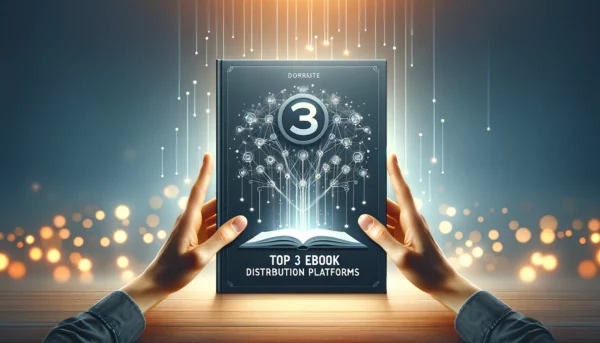The landscape of book distribution has undergone a transformative journey, tracing its origins from the tactile realms of traditional print to the expansive digital frontiers of the modern age. This evolution marks a significant pivot in the annals of publishing, where the once-dominant physical books now share the stage with their digital counterparts, leading to a dynamic and ongoing debate between the merits of digital vs. physical book distribution.
In the early days, the distribution of printed books was a straightforward yet logistically complex process, involving physical printing, storage, and transportation to various bookstores and libraries. This method, while rich in its tactile and visual appeal, presented limitations in terms of reach, cost, and environmental impact. The advent of digital technology heralded a new era, introducing e-books and digital platforms that revolutionized access to literature. Digital distribution bypassed many of the physical constraints, offering unparalleled convenience, accessibility, and a global reach at a fraction of the cost.
However, this shift towards digital formats has ignited a multifaceted debate among stakeholders in the publishing industry. Authors and publishers now face critical decisions regarding the distribution channels that best align with their goals, target audience, and the nature of the content itself. The choice between digital and physical distribution is not merely a technical consideration but a strategic one that affects visibility, reader engagement, and ultimately, the success of a book.
As we delve into the nuances of this debate, it is essential to understand the unique advantages, challenges, and implications of each distribution path. The decision between digital and physical book distribution holds significant relevance for authors and publishers, shaping the future of how stories are told, shared, and preserved in an ever-evolving literary landscape.
Start Your Publishing Journey FOR FREEThe Rise of Digital Books
The digital revolution within the realm of publishing marked a significant milestone with the advent of e-readers and digital platforms in the late 20th and early 21st centuries. This shift was not sudden but a gradual transition fueled by advancements in technology and changing consumer behaviors. The introduction of the first e-readers provided a new way to consume literature, marrying the convenience of technology with the timeless value of written content. These devices, coupled with the proliferation of digital platforms, allowed readers to access thousands of books at their fingertips, transforming the very essence of reading and book distribution.
The Impact and Advantages of Digital Books
The impact of digital books on the publishing industry is underscored by compelling statistics. Over the past two decades, e-book sales have seen exponential growth. According to data from the Association of American Publishers, e-books accounted for a significant percentage of total book sales, with numbers continuing to rise year over year. This surge in e-book popularity reflects a broader trend towards digital content consumption across media types.
The advantages of digital books are manifold, contributing to their rising popularity. From a cost perspective, digital books eliminate the need for physical materials and the associated production and distribution expenses. This cost-effectiveness extends to consumers, who can often purchase digital books at a lower price point than their physical counterparts. Furthermore, digital books are accessible to a global audience with internet access, breaking down geographical barriers that once limited the distribution of printed works.
Portability is another key benefit, as readers can carry entire libraries in their pockets, transforming downtime into an opportunity to delve into a new story or piece of knowledge. This unprecedented access to a vast array of titles encourages broader reading habits and democratizes access to information.
Environmental benefits also play a significant role in the appeal of digital books. By eliminating the need for paper, ink, and physical transportation, digital books offer a more sustainable alternative to traditional print, aligning with growing concerns about environmental conservation and sustainability.
The rise of digital books has undeniably changed the landscape of the publishing industry, introducing new opportunities and challenges. As digital platforms continue to evolve and e-reader technology advances, the way we think about books and reading is continually being reshaped, reflecting the dynamic interplay between tradition and innovation in the digital age.
The Enduring Appeal of Physical Books
In an era dominated by screens and digital interfaces, the allure of physical books endures, weaving a timeless charm that resonates with readers and authors alike. Despite the convenience and accessibility offered by digital formats, there’s a substantial segment of the literary community that remains steadfast in its preference for print books. This enduring appeal is rooted in a confluence of sensory experiences, emotional connections, and practical considerations that digital books struggle to replicate.
The tactile experience of reading a print book is unparalleled—a sentiment echoed by numerous book enthusiasts. The feel of paper between one’s fingers, the sound of turning pages, and even the distinct smell of a new or old book create a multisensory reading experience that is deeply immersive. This tactile engagement fosters a unique bond between the reader and the physical object, turning each printed book into a cherished possession rather than just a vessel of text.
Collectibility plays a significant role in the appeal of physical books. For many, books are more than just reading material; they are artifacts to be collected, displayed, and treasured. A well-curated bookshelf speaks volumes about an individual’s interests, journeys, and intellectual pursuits, serving as a physical manifestation of one’s literary journey. This aspect of collectibility and display is something digital books cannot offer, as a virtual library lacks the presence and personality of a physical collection.
Moreover, the physical presence of printed books adds a certain gravitas and accessibility that digital formats cannot match. Print books do not require batteries or electronic devices, making them perpetually available to their owners. They are also free from the distractions that often accompany digital devices, providing a focused and uninterrupted reading environment.
Certain genres, particularly children’s books, exemplify the irreplaceable value of print. The interactive nature of children’s literature, with its vibrant illustrations, tactile elements, and sometimes even moving parts, plays a crucial role in engaging young minds and fostering a love for reading. The physical interaction with these books is an integral part of the learning and entertainment experience, something that digital versions struggle to emulate fully.
Despite the surge in digital book sales and the convenience of e-readers, the significance of print book sales remains robust. Many readers continue to prefer purchasing physical copies, especially for books they hold dear or intend to share and gift. This preference underscores the fact that, for many, the value of a book goes beyond its content—it’s about the experience, the sentiment, and the physical connection that comes with owning a tangible piece of literature.
Start Your Publishing Journey FOR FREEComparing Distribution Models
The book publishing industry stands at a crossroads between traditional physical book distribution and the rapidly evolving digital distribution channels. This dichotomy presents a complex landscape for authors and publishers, each with distinct advantages, challenges, and strategic implications for book sales and market penetration.
Digital Distribution Channels
Digital book distribution has revolutionized the publishing industry, offering a plethora of various ebook platforms like Amazon Kindle, Apple Books, and Google Play Books, among others. This model is characterized by its low upfront costs, as it eliminates the need for physical printing, warehousing, and transportation. The ease of access and distribution allows authors to reach a global audience with the click of a button, significantly widening the potential reader base beyond geographical constraints.
The digital model offers a particularly attractive proposition for self-published and independent authors, who might find the traditional publishing barriers daunting. With digital platforms, these authors can bypass many of the traditional gatekeepers, directly reaching their audience without significant upfront investment. Additionally, the rise of print-on-demand services complements this digital shift, allowing physical copies to be printed as needed, further reducing the financial risk and storage issues associated with large print runs.
Physical Distribution Channels
In contrast, physical book distribution relies on a more traditional and tangible approach, involving the printing, stocking, and selling of physical books through bookstores, libraries, and other retail outlets. This model incurs higher upfront costs due to the printing and distribution logistics of paper books but offers a tangible product that many readers and authors still deeply value. Traditional print runs require significant investment and carry the risk of unsold inventory, making this model potentially riskier, especially for new or independent authors.
However, the physical book retains a unique advantage in its tangible presence, which can be crucial for certain genres and markets. For example, illustrated children’s books, high-quality art books, and limited editions often rely on the physical form to fully convey their value. Moreover, physical books offer opportunities for authors to connect with their audience through book signings, readings, and other in-person events, creating a personal connection that digital formats struggle to replicate.
Considerations for Authors and Publishers
Choosing between digital and physical distribution models involves careful consideration of several factors. For self-published and independent authors, the decision often hinges on the balance between reaching a wide audience with minimal upfront investment (digital) and the desire for the traditional credibility and sensory experience offered by physical books. Traditional publishers, on the other hand, often employ a hybrid model, leveraging the global reach of digital while maintaining a presence in the physical book market where it makes strategic sense.
The economics of publishing, therefore, is not a one-size-fits-all scenario but a strategic decision that depends on the book’s target audience, content type, and the author’s or publisher’s goals. While digital distribution offers unparalleled accessibility and efficiency, the physical book maintains its allure through the tactile experience and personal engagement it offers. As the publishing industry continues to evolve, understanding these distribution models’ nuances becomes crucial for navigating the complex landscape of book sales and reader engagement.
E-Book Distribution: Platforms and Formats
The digital revolution has given rise to a multitude of e-book platforms, each with its own set of features, formats, and distribution networks. Among the most prominent platforms for ebooks now are Amazon’s Kindle, Apple Books, and Barnes & Noble’s Nook, alongside others like Kobo and Google Play Books. These platforms have become the backbone of e-book distribution, providing authors and publishers with access to vast audiences across the globe.
Major E-Book Platforms
Amazon Kindle, arguably the most widely recognized e-book platform, has a vast user base and offers a range of publishing tools for authors through its Kindle Direct Publishing (KDP) program. Apple Books caters to users within the Apple ecosystem, providing a seamless reading experience across all Apple devices. Barnes & Noble’s Nook and other platforms like Kobo offer competitive alternatives, each with its unique strengths and market reach. These platforms require specific formatting to ensure that e-books are compatible and presentable across different devices and software versions.
Formatting for Digital Distribution
Formatting e-books for digital distribution involves converting manuscripts into formats such as EPUB, MOBI (primarily for Kindle), and PDF, among others. This process ensures that text and images display correctly, links are functional, and the overall layout is preserved across various screen sizes and devices. Authors and publishers may use specialized software or services to format their books, ensuring they meet the technical specifications of each platform.
Digital Rights Management (DRM)
DRM plays a crucial role in e-book distribution, aimed at preventing unauthorized distribution and copying of digital books. While DRM helps protect intellectual property, it also introduces limitations on how e-books can be shared and used across different devices. For instance, an e-book purchased on the Kindle platform may not be readable on a Nook device due to DRM restrictions. Authors and publishers must carefully consider the implications of DRM on their e-books’ accessibility and reader experience.
Compatibility Across Devices
Ensuring compatibility across various e-readers and digital devices is paramount for successful e-book distribution. Readers expect to access their e-books on multiple devices, from dedicated e-readers like Kindle and Nook to smartphones and tablets. This necessitates a focus on responsive design and flexible formatting, allowing e-books to adapt to different screen sizes and orientations without compromising the reading experience.
E-book distribution encompasses a complex ecosystem of platforms, formats, and technical considerations. Authors and publishers navigating this landscape must balance the protection of their works through DRM with the need for broad compatibility and an optimal reading experience. As the digital publishing world continues to evolve, staying informed about these aspects is essential for maximizing the reach and impact of e-book distribution.
Uploading and Distributing Your Book
Navigating the landscape of book distribution can be an intricate process, given the plethora of platforms and the detailed requirements each one entails. However, with a structured approach, authors can demystify this process, ensuring their literary creations reach their intended audience with ease.
The journey begins with the meticulous preparation of your manuscript. This stage involves more than just finalizing your text; it encompasses professional editing to refine the narrative, formatting the content to meet platform-specific standards, and designing an engaging cover that resonates in both digital thumbnails and physical print. This foundational step is crucial, as it sets the tone for how your book is perceived and received in the competitive literary market.
Simplifying Distribution with Spines
For authors seeking a seamless distribution experience, Spines presents an innovative solution that revolutionizes the traditional approach. Spines’ platform empowers authors to bypass the cumbersome process of individual platform uploads. With a single click, your book is propelled into countless global distribution channels, encompassing industry giants such as Amazon and Barnes & Noble. This expansive reach is not just about quantity; it’s about strategically placing your book in the pathways of diverse reader segments.
The process of uploading and distributing your book need not be a labyrinth of complexity. With the right preparation, platform selection, and innovative tools like Spines, authors can navigate this journey with confidence. Embracing a streamlined approach not only maximizes your book’s visibility across a spectrum of channels but also affords you the clarity and control to drive your publishing success in today’s dynamic literary landscape.
Start Your Publishing Journey FOR FREEPhysical Book Distribution: Challenges and Opportunities
The distribution of physical books, while traditional, presents a unique set of challenges and opportunities that continue to make it a vital part of the publishing landscape. The logistics involved in printing, storing, and shipping books are complex and can significantly impact the overall cost and accessibility of physical literature.
Logistical Challenges
The journey of a physical book from manuscript to reader involves several logistical steps, each with associated costs and complexities. Printing requires upfront investment in the production of physical copies, a cost that varies widely depending on the book’s size, page count, and print quality. Once printed, these paper books need to be stored in warehouses, adding storage costs to the equation. Shipping then becomes the final logistical hurdle, with costs fluctuating based on distance, volume, and shipping methods. These logistical elements make physical book distribution more capital-intensive than digital alternatives, posing a significant challenge for new authors and small publishers.
Value of Physical Presence
Despite these challenges, the physical presence of books in bookstores and other retail environments holds considerable value. A well-designed cover can attract potential readers’ attention, making cover design and physical quality critical factors in a book’s market success. The tangible nature of physical books also allows for a more engaging browsing experience in bookstores, where the look, feel, and even the smell of books contribute to the purchasing decision. Furthermore, the physical presence of a book in stores can enhance its visibility and credibility, factors that are often crucial for new authors seeking to establish themselves.
Environmental Considerations
The environmental impact of printing and distributing physical books is a growing concern. The paper industry is one of the largest consumers of water and forest resources, leading to significant environmental footprints. However, this challenge also presents an opportunity for the industry to adopt more sustainable practices. The use of recycled paper, environmentally friendly inks, and more efficient printing and distribution methods can mitigate some of the environmental impacts. Publishers and authors are increasingly aware of these considerations, and many are actively seeking ways to make their physical book distribution more environmentally friendly.
In conclusion, while physical book distribution comes with its set of challenges, from logistical complexities to environmental concerns, it also offers unique opportunities. The tangible presence of books in stores, the impact of physical design elements on sales, and the potential for adopting sustainable practices all contribute to the enduring relevance of physical books in the digital age. As the publishing industry continues to evolve, finding a balance between these challenges and opportunities will be key to the success and sustainability of physical book distribution.
Consumer Preferences and Market Trends
Understanding consumer preferences is crucial in the evolving landscape of book publishing, where the balance between digital and physical formats is constantly shifting. Insights from research institutions like Pew Research Center, along with various market studies, shed light on the nuanced preferences of readers when it comes to e-books versus print books.
Studies consistently reveal a complex picture: while e-books have gained significant traction due to their convenience and accessibility, print books continue to hold a substantial and often preferred place in readers’ lives. Surveys indicate that the tactile experience, ease of use, and the absence of digital distractions associated with the print versions of books contribute to their enduring popularity. However, the portability, storage capacity, and features like adjustable font sizes make e-books particularly appealing to certain demographics, including commuters and avid travelers.
Demographic trends reveal interesting insights, particularly among younger readers who are generally presumed to favor digital formats due to their tech-savvyness. While it’s true that younger demographics show a growing acceptance of e-readers, many still express a strong preference for print books, citing reasons such as reduced screen time and the physical experience of reading. This suggests that despite the digital inclination of younger generations, the appeal of traditional books transcends age barriers.
Future predictions for the balance between digital and physical book sales point towards a coexistence rather than a competition. The market is likely to continue accommodating both formats, catering to varied preferences and situations. While certain genres and uses may lean more heavily towards digital formats, print books are expected to maintain a significant presence, particularly in areas where the physical book offers irreplaceable value, such as children’s literature, coffee table books, and collectible editions.
Consumer preferences in the book market are diverse and dynamic, influenced by a range of factors from convenience to the sensory experience of reading. As technology advances and reading habits evolve, the publishing industry will need to remain adaptive, ensuring both digital and physical formats continue to meet the diverse needs and preferences of readers.
Start Your Publishing Journey FOR FREEMaking the Right Choice for Your Book: Digital vs Physical Book Distribution
In the diverse ecosystem of book publishing, authors and publishers face the critical decision of choosing the most appropriate distribution model for their work. This choice between digital and physical distribution is influenced by several key factors, each playing a pivotal role in the book’s potential success and reach.
Key Considerations
Target Audience: Understanding the preferences and reading habits of the intended audience is paramount. Younger demographics may be more inclined towards digital formats for convenience, while certain groups may prefer the tactile experience of physical books. Identifying the primary audience helps tailor the distribution strategy to their expectations.
Genre: The nature of the content significantly influences the choice of distribution. Text-heavy genres like non-fiction and novels may thrive in digital formats, offering ease of access and portability. Conversely, genres relying heavily on visual elements, such as art books and children’s literature, often find a better home in physical form, where the quality of printing enhances the reader’s experience.
Personal Goals: Authors and publishers must also consider their objectives, whether reaching the widest possible audience, maximizing profitability, or maintaining control over the publishing process. Digital distribution may offer a broader reach with lower upfront costs, while physical books can contribute to building a tangible brand presence.
The Hybrid Approach:
Embracing a hybrid model that incorporates both digital and physical distribution can often be the most cost-effective strategy. This approach allows for the maximization of reach and accessibility, catering to diverse reader preferences and adapting to different situations or contexts. A hybrid strategy ensures that a book’s availability is not limited by format, thus increasing its potential impact.
By carefully considering factors such as the target audience, genre, and personal publishing goals, authors and publishers can make informed decisions that align with their vision and the book’s content. Adopting a flexible, hybrid approach can further enhance a book’s reach, ensuring it connects with as many readers as possible in a format that resonates with them.
Conclusion
In navigating the complex terrain of book distribution, authors and publishers are presented with a spectrum of choices, each with its distinct advantages and challenges. From the tactile allure of physical books to the accessibility and reach of digital editions, the landscape is rich and varied. The advent of platforms like Spines further simplifies the distribution process, offering a seamless bridge between authors and a global audience.
As the publishing world continues to evolve, the key to success lies in understanding and adapting to the dynamic interplay of technologies, market trends, and reader preferences. Embracing both traditional and innovative distribution methods can maximize a book’s potential, ensuring it finds its way into the hands of eager readers, regardless of their preferred format.
Start Your Publishing Journey FOR FREE














